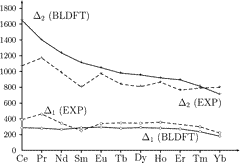Abstract of Publication No. 515
 M. Atanasov, C. Daul, H. U. Güdel, T. A. Wesolowski and M. Zbiri
M. Atanasov, C. Daul, H. U. Güdel, T. A. Wesolowski and M. Zbiri
Ground States, Excited States, and Metal-Ligand Bonding in Rare Earth Hexachloro Complexes:
A DFT-Based Ligand Field Study
Inorg. Chem. 44, 2954-2963 (2005)
![]()
![]()
![]()
Abstract:
Metal (4f)-ligand (Cl 3p) bonding in LnCl63–
(Ln = Ce to Yb) complexes has been studied on the basis of
4f![]() 4f and
Cl,3p
4f and
Cl,3p![]() 4f charge-transfer spectra and on the analysis
of these spectra within the valence bond configuration interaction model to show
that mixing of Cl 3p into the Ln 4f ligand field orbitals does not exceed 1%.
Contrary to this, Kohn-Sham formalism of density functional theory using
currently available approximations to the exchange-correlation functional tends
to strongly overestimate 4f-3p covalency, yielding, for
YbCl63-, a much larger mixing of Cl
3p
4f charge-transfer spectra and on the analysis
of these spectra within the valence bond configuration interaction model to show
that mixing of Cl 3p into the Ln 4f ligand field orbitals does not exceed 1%.
Contrary to this, Kohn-Sham formalism of density functional theory using
currently available approximations to the exchange-correlation functional tends
to strongly overestimate 4f-3p covalency, yielding, for
YbCl63-, a much larger mixing of Cl
3p![]() 4f charge transfer into the f13 ionic
ground-state wave function. Thus, ligand field density functional theory, which
was recently developed and applied with success to complexes of 3d metals in our
group, yields anomalously large ligand field splittings for Ln, the discrepancy
with experiment increasing from left to the right of the Ln 4f series. It is
shown that eliminating artificial ligand-to-metal charge transfer in Kohn-Sham
calculations by a procedure described in this work leads to energies of 4f-4f
transitions in good agreement with experiment. We recall an earlier concept of
Ballhausen and Dahl which describes ligand field in terms of a pseudopotential
and give a thorough analysis of the contributions to the ligand field from
electrostatics (crystal field) and exchange (Pauli) repulsion. The close
relation of the present results with those obtained using the first-principles
based and electron density dependent effective embedding potential is pointed
out along with implications for applications to other systems.
4f charge transfer into the f13 ionic
ground-state wave function. Thus, ligand field density functional theory, which
was recently developed and applied with success to complexes of 3d metals in our
group, yields anomalously large ligand field splittings for Ln, the discrepancy
with experiment increasing from left to the right of the Ln 4f series. It is
shown that eliminating artificial ligand-to-metal charge transfer in Kohn-Sham
calculations by a procedure described in this work leads to energies of 4f-4f
transitions in good agreement with experiment. We recall an earlier concept of
Ballhausen and Dahl which describes ligand field in terms of a pseudopotential
and give a thorough analysis of the contributions to the ligand field from
electrostatics (crystal field) and exchange (Pauli) repulsion. The close
relation of the present results with those obtained using the first-principles
based and electron density dependent effective embedding potential is pointed
out along with implications for applications to other systems.